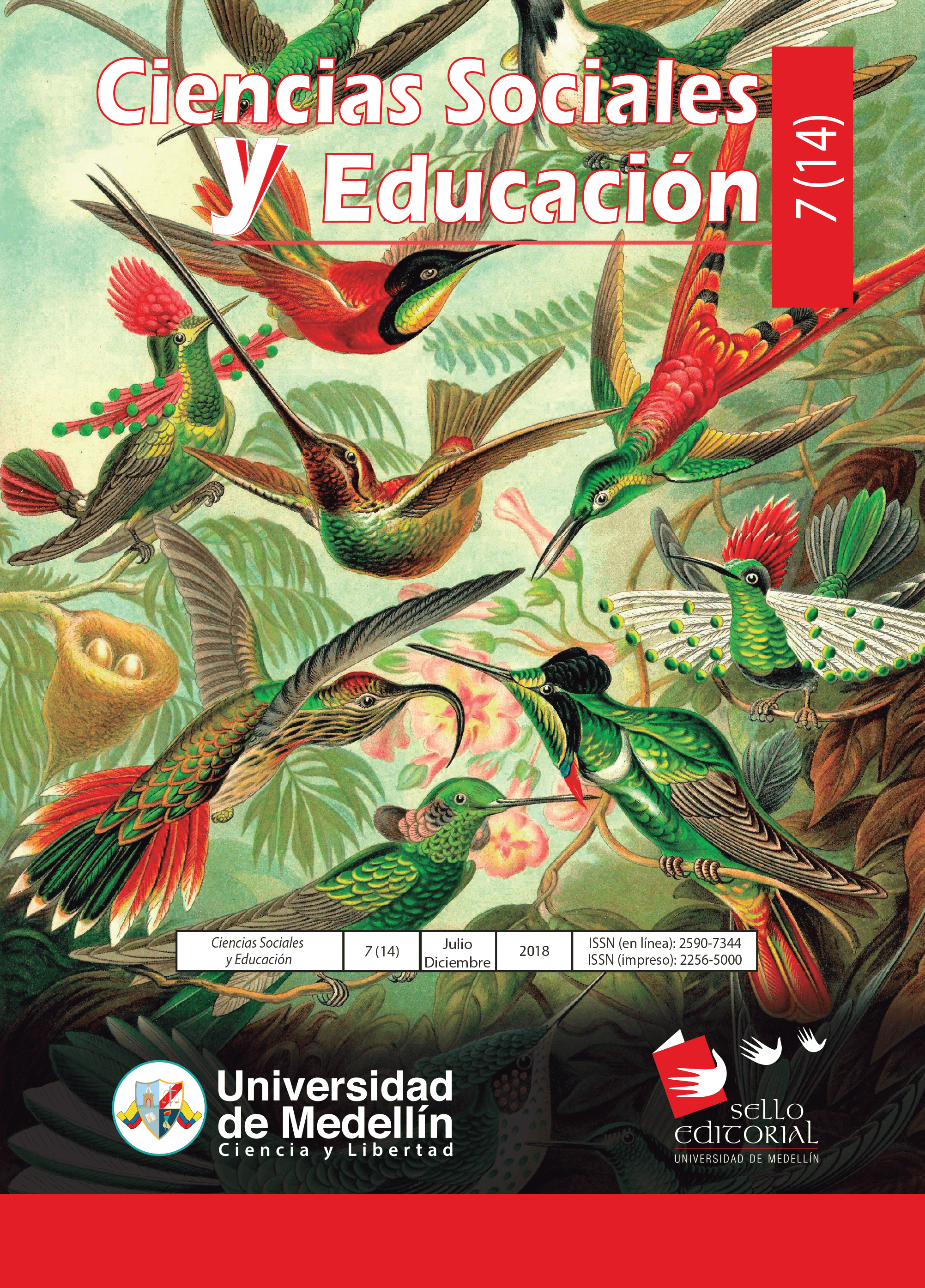Multimodal tool Based on Tasks for Learning English in Sixth Grade in Florencia, Caquetá (Colombia)
Main Article Content
Abstract
This article gives an account of a research-action educational process which main objective was proposing a multimodal context-based tool that based upon Task-based Learning (TBL) to contribute to the English learning process of a group of students from sixth grade in a public school in Florencia, Caquetá. This tool was designed grounded on document analysis, polls and diagnostic assessments. A field diary and work evidence from the students was used for its implementation. The results suggest that the contextualized resources, the multimodality, and the TBL encourage effective learning environments in which students build their knowledge from their interest topics, fro resources such as video games, games, and digital platforms to develop integrally its language abilities.
Article Details
References
Álvarez, J. (2016). Meaning making and communication in the multimodal age: ideas for language teachers. Colombian Applied Linguistics Journal, 18(1), 98-115.
Aldana, Y., Baquero, M., Rivero, G., y Romero, D. (2012). Applying Connectivist Principles and the Task-Based Approach to the Design of a Multimodal Didactic Unit. HOW, 19(1), 93-122.
Castillo Losada, C. A., Insuasty, E. A., y Jaime Osorio, M. F. (2017). The impact of authentic materials and tasks on students’ communicative competence at a Colombian language school. Profile Issues in Teachers’ Professional Development, 19(1), 89-104. doi: http://dx.doi.org/10.15446/profile.v19n1.56763
Coffey, A., y Atkinson, P. (2003). Encontrar el sentido a los datos cualitativos: estrategias complementarias de investigación. Medellín: Universidad de Antioquia.
Cresswell, J. (2009). Research Design. Qualitative, Quantitative, and Mixed Methods. Los Ángeles: University of Nebraska-Lincoln.
Elliot, J. (2000). La investigación-acción en educación. Madrid: Morata.
Ellis, R. (2003). Task-based Language Learning and Teaching. Nueva York: Oxford University Press.
Farías, M., Obilinovic, K., y Orrego, R. (2010). Modelos de aprendizaje multimodal y enseñanza-aprendizaje de lenguas extranjeras. UT. Revista de Ciències de l’Educació, 55-74.
García, D., García, J., y Hernández, Y. (2011). Students’ beliefs: Multimodal Texts as Pedagogical Tools in Foreign Language Learning. Revista Papeles, 3(5), 21-35.
Hernández, R., Fernández, C., y Baptista L. (2014). Metodología de la Investigación. Ciudad de México: McGraw-Hill.
Howard, J., y Major , J. (2004). Guidelines for designing effective English language teaching materials. 9th Conference of Pan Pacific Association of Applied Linguistic Conference. 101–109. Recuperado de http://www.paaljapan.org/resources/proceedings/PAAL9/pdf/Howard.pdf
Jiménez, J. (2013). Ayudas en línea para la lectura multimodal en lengua extranjera. Bellaterra Journal of Teaching & Learning Language & Literature, 6(2), 69-92.
Kress, G. (2010). Multimodality a Social Semiotic Approach to Contemporary Communication. Londres y Nueva York: Routledge Taylor & Francis Group.
Martínez, M. (2013). Experiencia de enseñanza multimodal en una clase de idiomas. Ensayos, Revista de la Facultad de Educación de Albacete (28), 1-13.
Martínez, M., y Llorens, E. (2016). Aproximación al uso de recursos multimodales y de las TICs en la enseñanza del inglés. Recuperado de http://hdl.handle.net/10045/58347
Ministerio de Educación Nacional. (2016a). Diseñando una Propuesta de Currículo Sugerido de Inglés para Colombia. Grados 6° a 11°. English for Diversity and Equity. Recuperado de http://aprende.colombiaaprende.edu.co/sites/default/files/naspublic/Anexo%2016%20Dise%C3%B1o%20Propuesta%20%20Curriculo%20Sugerido.pdf
Ministerio de Educación Nacional. (2016b). Orientaciones y Principios Pedagógicos. Currículo Sugerido de inglés. Grados 6° a 11°. English for Diversity and Equity. Recuperado de http://aprende.colombiaaprende.edu.co/sites/default/files/naspublic/Anexo%2014%20Orientaciones%20y%20principios%20Pedagogicos.pdf
Monsalve, M., Chaverra, D., y Bolívar, W. (2015). Caracterización y evaluación de la habilidad de razonabilidad en la producción escrita de textos multimodales. Forma y función, 28(2), 111-133.
New London Group. (1996). A Pedagogy of Multiliteracies: Designing Social Futures. Harvard Educational Review, 66(1), 60-93.
Nunan, D. (1989). Designing Tasks for the Communicative Classroom. Inglaterra: Cambridge University Press.
Nunan, D. (1991). Language Teaching Methodology. A tetxbook for teachers. Sidney: Prentice Hall.
Núñez , A., Pineda, C., y Téllez, M. (2004). Key Aspects for Developing Your Instructional Materials. Profile, 5(1), 128-139.
Núñez, A., Téllez, M., y Castellanos, J. (2012). A framework for materials development: A path for in-service teachers to build up the instructional design of their research projects. En A. Núñez, M. F.
Téllez y J. Castellanos (Eds.), Teacher research on English didactics issues (pp. 17-37). Bogotá: Departamento de Publicaciones Universidad Externado de Colombia.
Núñez, A., Téllez, M., y Castellanos, J. (2017). Materials development for teacher’s professional growth. En A. Núñez, M. Téllez, y J. Castellanos (Eds.), Materials for the learning of English and teacher’s professional growth (pp. 19-68). Bogotá: Departamento de Publicaciones Universidad Externado de Colombia.
Ochoa, D., y Medina, N. (2013). A Virtual Room to Enhance Writing Skills in the EFL Class. HOW, 21(1), 62-81.
Pereira, H., y Ramos, L. (2016). Diseño de libros de texto para la enseñanza del inglés: una propuesta curricular. Colomb. Appl. Linguist. J., 8(2), 139-150. Recuperado de http://www.redalyc.org/articulo.oa?id=305746478012
Polyxeni, M., y Papadopoulou, M. (2013). Greek Students’ Familiarity with Multimodal Texts in EFL. The Internacional Journal of Literacies, 19(1), 37-46. Recuperado de https://cgscholar.com/bookstore/works/greek-students-familiarity-with-multimodal-texts-in-efl
Rincón, J., y Clavijo-Olarte, A. (2016). Fostering EFL learners’ literacies through local inquiry in a multimodal experience. Colombian Applied Linguistic Journal, 18(2), 67-82.
Smith, K. (1996). Cooperative learning: Making 'groupwork' work. En C. Bonwell, y T. Sutherlund, Active learning: Lessons from practice and emerging issues. New Directions for Teaching and Learning (pp. 71-82). San Francisco, EE.UU: Jossey-Bass.
Tomlinson, B. (2003). Developing Materials for Language Teaching. Trowbridge: Croomwell Press.
Zambrano, L., Cárdenas, M., y Insuasty, E. (2011). Communicative Learning Tasks. Bogotá: Litocentral.





